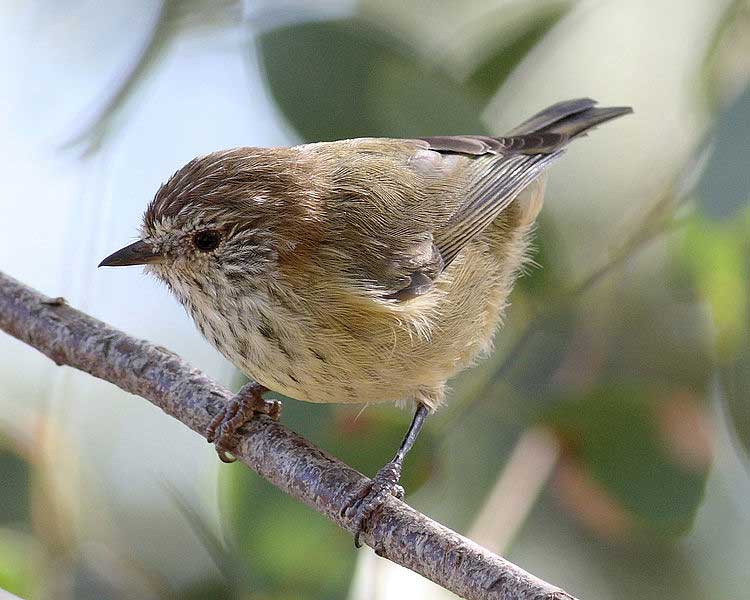
Acanthiza lineata (*)
Superregnum: Eukaryota
Regnum: Animalia
Subregnum: Eumetazoa
Cladus: Bilateria
Cladus: Nephrozoa
Superphylum: Deuterostomia
Phylum: Chordata
Cladus: Craniata
Subphylum: Vertebrata
Infraphylum: Gnathostomata
Superclassis: Tetrapoda
Cladus: Reptiliomorpha
Cladus: Amniota
Classis: Reptilia
Cladus: Eureptilia
Cladus: Romeriida
Subclassis: Diapsida
Cladus: Sauria
Infraclassis: Archosauromorpha
Cladus: Crurotarsi
Divisio: Archosauria
Subsectio: Ornithodira
Subtaxon: Dinosauromorpha
Cladus: Dinosauria
Ordo: Saurischia
Cladus: Eusaurischia
Cladus: Theropoda
Cladus: Neotheropoda
Infraclassis: Aves
Ordo: Passeriformes
Subordo: Passeri
Parvordo: Corvida
Superfamilia: Meliphagoidea
Familia: Acanthizidae
Genus: Acanthiza
Species : Acanthiza lineata
Subspecies : A. l. alberti – A. l. chandleri – A. l. clelandi – A. l. lineata – A. l. whitei
Name
Acanthiza lineata Gould, 1838
References
Gould, John, 1838: A synopsis of the birds of Australia, and the adjacent islands. Part 4, pl. 59 (PDF)
Vernacular names
বাংলা: আচানথিযা লাইনাটা
Deutsch: Stricheldornschnabel
English: Striated Thornbill
español: Acantiza estriada
فارسی: نوکخاری نواری
français: Acanthize ridé
Nederlands: Twijgdoornsnavel
The striated thornbill (Acanthiza lineata) is a species of bird in the family Acanthizidae. It is endemic to Australia, where its natural habitat is subtropical or tropical dry forests.
Taxonomy
John Gould described the striated thornbill in 1838, giving it the common name of striated acanthiza.[3] Alternative common names include striped-crowned thornbill or tit-warbler, striated tit-warbler or tit, and green thornbill.[4]
The striated thornbill still bears its original name.[5]
A 2017 genetic study using both mitochondrial and nuclear DNA found that the ancestor of the striated thornbill diverged from that of the yellow thornbill around 6 million years ago.[6]
Four subspecies are recognised.[7]
A. lineata alberti is found in southeast Queensland and is paler and more yellowish overall than the nominate subspecies. It has a bright orange-brown cap with prominent white streaks, and a yellow-olive back. There is a broad zone of intermediate birds stretching from Tenterfield south to Port Macquarie on the coast and Tamworth inland.[7]
A. lineata lineata is found across New South Wales and Victoria, with a zone between the Grampians and Warrnambool, and the South Australian border where intermediate forms between this and clelandii are found.[7]
A. lineata clelandii is smaller and paler than the nominate subspecies, though has a more greyish back. It is found in southeastern South Australia to Adelaide.[7]
A. lineata whitei is smaller and darker than the nominate subspecies, with an overall greyish cast. It is found on Kangaroo Island.[7]
Description
The adult striated thornbill is 9–10 centimetres (3.5–3.9 in) long and weighs around 7 grams (0.25 oz).[8] It has a russet- or orange-brown crown with cream streaks, dull yellow-olive upperparts, olive-grey flanks, and cream underparts heavily streaked with black.[7]
The brown thornbill (A. pusilla) is similar but lacks the white-streaked orange-brown cap and lives in shrubs.[8]
Feeding
The striated thornbill is predominantly insectivorous, generally forages in the canopy of eucalypt trees, gleaning leaves for prey. It often hangs upside-down while foraging.[9] The striated thornbill also visits and feeds on extra-floral nectaries on the leaves of sunshine wattle (Acacia terminalis), helping pollinate the plant as it brushes against flower heads while feeding.[10]
Breeding
Striated thornbills form flocks of 7–20 birds outside of breeding season from late summer to winter, before breaking up into groups of 2–4, composed of a breeding pair plus helper birds.[9]
References
BirdLife International (2016). "Acanthiza lineata". IUCN Red List of Threatened Species. 2016: e.T22704656A93979528. doi:10.2305/IUCN.UK.2016-3.RLTS.T22704656A93979528.en. Retrieved 16 November 2021.
Gill F, D Donsker & P Rasmussen (Eds). 2020. IOC World Bird List (v10.2). doi : 10.14344/IOC.ML.10.2.
Gould, John (1865). Handbook to The birds of Australia, Volume 1. self. pp. 372.
Gray, Jeannie; Fraser, Ian (2013). Australian Bird Names: A Complete Guide. Collingwood, Victoria: Csiro Publishing. p. 187. ISBN 978-0-643-10471-6.
Australian Biological Resources Study (4 December 2014). "Subspecies Acanthiza (Subacanthiza) lineata lineata Gould, 1838". Australian Faunal Directory. Canberra, Australian Capital Territory: Department of the Environment, Water, Heritage and the Arts, Australian Government. Retrieved 5 February 2017.
Marki, Petter Z.; Jønsson, Knud A.; Irestedt, Martin; Nguyen, Jacqueline M.T.; Rahbek, Carsten; Fjeldså, Jon (2017). "Supermatrix phylogeny and biogeography of the Australasian Meliphagides radiation (Aves: Passeriformes)". Molecular Phylogenetics and Evolution. 107: 516–29. doi:10.1016/j.ympev.2016.12.021. hdl:10852/65203. PMID 28017855.
Schodde, Richard; Mason, Ian J. (1999). Directory of Australian Birds: Passerines: Passerines. pp. 216–18. ISBN 9780643102934.
"Striated thornbill". Birds in Backyards. Birdlife Australia. Retrieved 5 February 2017.
Bell, Harry L.; Ford, Hugh A. (1986). "A Comparison of the Social Organization of Three Syntopic Species of Australian Thornbill, Acanthiza". Behavioral Ecology and Sociobiology. 19 (6): 381–92. doi:10.1007/bf00300540. JSTOR 4599974. S2CID 6197201.
Knox, R.B.; Kenrick, J.; Bernhardt, P.; Marginson, R.; Beresford, G.; Baker, I.; Baker, H.G. (1985). "Extrafloral nectaries as adaptations for bird pollination in Acacia terminalis". American Journal of Botany. 72 (8): 1185–96. doi:10.1002/j.1537-2197.1985.tb08371.x. JSTOR 2443398.
русский: Полосатая шипоклювка
svenska: Strimmig taggnäbb
Retrieved from "http://en.wikipedia.org/"
All text is available under the terms of the GNU Free Documentation License

